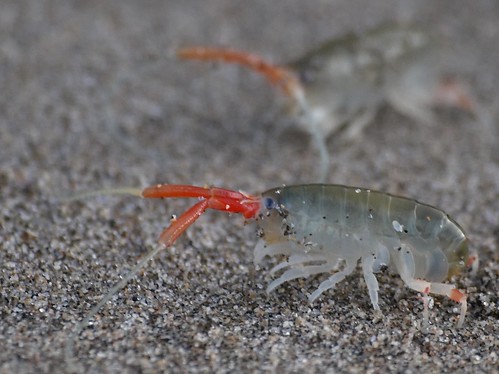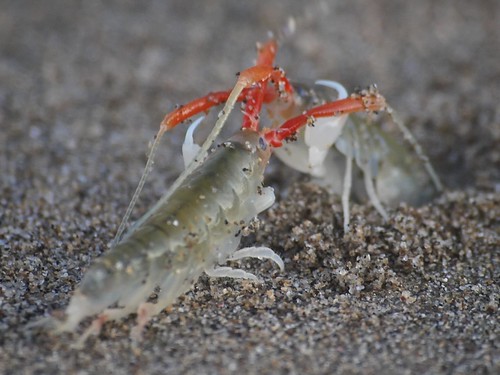My late dad and I share a gene that — due to a missed deadline with the Humane Genome Project — hasn’t been mapped for posterity. He dreamed (and I dream) in preposterous anachronisms and juxtapositions.
One of Dad’s recurring dreams was about a horse in a penthouse apartment who would fling himself off the balcony and into the pool below when someone shouted a certain word.
I shouldn’t be surprised then, when I’m minding my own business in my alpha waves, and suddenly, a giant beach flea with a martini is getting existential on me.
Beach fleas aren’t totally out of context. I have, actually, photographed them on the sands of Mendocino County. Still — in my maze of neurons and synapses, I can’t seem to remember where I parked my car, but I retain a full-color anatomical breakdown of a beach flea.
In order to purge that image . . . in homage to my dream-time specter, the flea . . . and with respect to my dad’s vivid and alternate universe . . . I’m re-posting my original and first impressions of Mendocino’s beach-hopping amphipods, photographed in June of 2009.
—————————————————————————————————
As fleas go, they’re giants. Not giants in the sense of Bikini-Atoll-nuclear-mutant-gone-bad giants. But by flea standards, they’re positively huge — about 1 inch long. That’s probably because they’re not parasitic dog or cat fleas, but rather, amphipods — shrimp-like creatures who dine on organic matter at the outer limits of the tideline.
This was our first face-to-face with a beach flea, also known as the California Beach Hopper. It was sunrise on a Mendocino Beach with a -2.1 tide — a beach surprisingly devoid of abalone divers along a coastline literally trampled by them.
In our solitude, we had the time and space to look between our toes. And for the squeamish, what we saw was squirm worthy: hundreds of translucent flea-like figures hopping and falling in the sand around us.
They might as well be drunk the way they hop and stumble. I know this because I was flat on the sand, watching them through my telephoto as they jumped, then tumbled, jumped then tumbled. And as they fell, invariably, another Beach Hopper would arrive to challenge the fallen flea. A scuffle of sorts would ensue, and then each beach flea would move on. The Beach Hoppers with burrows weren’t immune from intrusion either, as this photo establishes:
I confess that I can’t distinguish between amiable and antagonistic actions of beach fleas, but my understanding is that mating occurs in the burrow, and that what I was seeing outside probably constituted territorial exploration and arguments over burrows.
Beach Hoppers were at this spot because it happened to be on the cusp of the high-tide seaweed line. They dine upon elements of seaweed. They’re normally out and about at night — sometimes in the early morning hours. They themselves become food for animals like shorebirds, so the acquisition of a burrow is undoubtedly high on the priority list.

Beach Flea Heading Home - ©ingridtaylar
Related post: A Budding Amphipodologist




Fantastic photos, Ingrid. Yeah, I can see one with a martini.
Thanks, Tovar, for stopping by my den of bizarre tangents.